
The Cottidae are a family of fish in the superfamily Cottoidea, the sculpins. It is the largest sculpin family, with about 275 species in 70 genera. They are referred to simply as cottids to avoid confusion with sculpins of other families.

Cottus is a genus of the mainly freshwater ray-finned fishes belonging to the family Cottidae, the typical sculpins. They are often referred to as the "freshwater sculpins", as they are the principal genus of sculpins to be found in fresh water. They are native to the Palearctic and Nearctic.
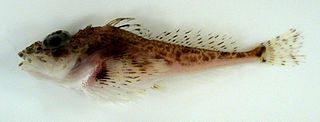
The scaled sculpins, Icelus, are a genus of marine ray-finned fishes belonging to the family Cottidae, the typical sculpins. Most of the fishes in this genus are found in the northern Pacific Ocean but they also occur in the North Atlantic Ocean.

The snubnose sculpin is a species of marine ray-finned fish belonging to the family Cottidae, the typical sculpins. This fish is found in the eastern Pacific Ocean.

The Pacific staghorn sculpin is a species of marine ray-finned fish belonging to the family Cottidae, the typical sculpins. This species is found in the eastern Pacific Ocean. It is the only species in the monospecific genus Lepidocottus.

Clinocottus globiceps, the mosshead sculpin or globe-headed sculpin, is a species of marine ray-finned fish belonging to the family Cottidae, the typical sculpins. This sculpin is found in the northeastern Pacific.

Clinocottus acuticeps, the sharpnose sculpin, is a species of marine ray-finned fish belonging to the family Cottidae, the typical sculpins. This sculpin is found in the eastern Pacific Ocean.
The Andriyashev largeheaded sculpin is a species of marine ray-finned fish belonging to the family Cottidae, the typical sculpins. This species is found in the northwestern Pacific Ocean. This monospecific genus, and therefore this species, are known from a single specimen, the holotype. This was collected from off Simushir Island in the Kuril Islands at a depth of 100 metres (330 ft). That specimen had a total length of 23.6 cm (9.3 in) long. FishBase classifies this taxon within the Cottidae but other authorities classify it within the subfamily Psychrolutinae of the family Psychrolutidae. The genus name Andriashevicottus includes a patronym, the person honoured was not identified by the describer Fedorov, however, it is almost certainly the Soviet ichthyologist Anatoly Petrovich Andriashev, the patronym is suffixed with Cottus, the type genus of the family Cottidae. The specific name megacephalus means "big head".

Artedius is a genus of marine ray-finned fishes belonging to the family Cottidae, the typical sculpins. These fishes are found in the northern Pacific Ocean.

The roughback sculpin is a species of marine ray-finned fish belonging to the family Cottidae, the typical sculpins. This species is found in the eastern Pacific Ocean. The roughback sculpin is the only known member of the genus Chitonotus.

Enophrys is a genus of marine ray-finned fishes belonging to the family Cottidae, the typical sculpins. These fishes are found in the northern and eastern Pacific Ocean.

Icelinusis a genus of marine ray-finned fishes belonging to the family Cottidae, the typical sculpins. These fishes are found in the northern and eastern Pacific Ocean.
The lavender sculpin is a species of marine ray-finned fish belonging to the family Cottidae, the typical sculpins. It is found in the eastern Pacific Ocean.
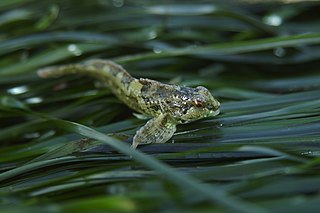
Oligocottus is a genus of marine ray-finned fishes belonging to the family Cottidae, the typical sculpins. These sculpins are found in the northern and eastern Pacific Ocean.
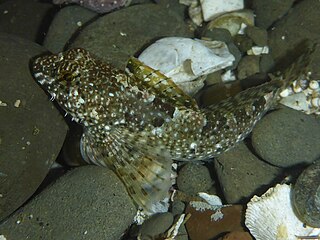
The woolly sculpin is a species of ray-finned marine fish belonging to the family Cottidae, or the typical sculpins. It is found in the eastern Pacific Ocean, where it occurs along the coastline of California south to Baja California.
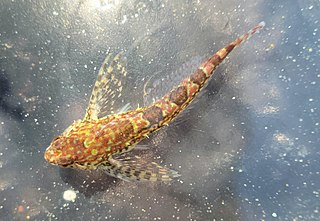
The saddleback sculpin is a species of fish in the sculpin family Cottidae. It is known to inhabit the North American shore of the Pacific Ocean. It is a very understudied fish with limited knowledge of behavioral patterns, lifecycle and reproduction.

The bald sculpin is a species of marine ray-finned fish belonging to the family Cottidae, the typical sculpins. It is found in the eastern Pacific Ocean.

The butterfly sculpin is a species of fish in the family Agonidae. It is found in the North Pacific Ocean.
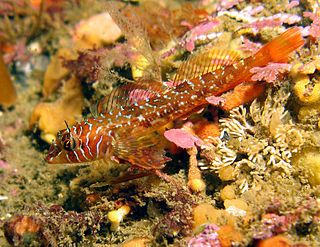
Jordaniidae is a small family of marine ray-finned fishes belonging to the order Scorpaeniformes. These fishes are found in the eastern North Pacific Ocean.

Clinocottus embryum, the calico sculpin or mossy sculpin, is a species of marine ray-finned fish belonging to the family Cottidae, the typical sculpins. It is found in the eastern Pacific Ocean.

















